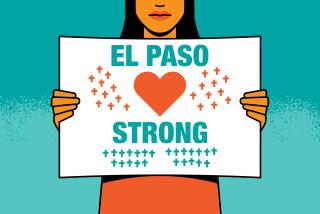Peso Falls; San Ysidro Loses Tijuana Shoppers
- Share via
SAN YSIDRO — Maria Vasquez reached into her cash register and pulled out a crumpled $1 bill.
“Only $1, that’s my total capital output for today,” said Vasquez, who runs a clothing store along San Ysidro Boulevard here, just a few blocks from the international border. “That’s all I’ve sold, all day long.”
Vasquez’s lament was echoed by other shop owners along the boulevard whose businesses depend on shoppers from nearby Tijuana. On the day after the value of the Mexican peso reached an all-time low of 500 to the dollar, many Mexican shoppers appeared to be staying at home or buying their goods in Mexico.
Experts said there is little relief in site for the beleaguered peso. Although the precise cause of the most recent plunge in the peso’s worth has puzzled observers, many blamed the moribund state of the Mexican economy, pointing to factors such as a loss of oil revenues, lack of confidence in the government and the resulting flight of capital and, most recently, the earthquake that devastated Mexico City.
“The peso’s been falling for a long time because of the state of the Mexican economy,” said Donald Wyman, acting director of the Center for U.S.-Mexican Studies at UC San Diego. “The earthquake certainly made a bad situation worse.”
Javier Banuelos agrees. “Business has been way down,” said Banuelos, manager of the Calimex grocery store here, which also caters to a clientele of Mexican nationals. He said sales had declined 30% to 50% in the last week since the peso began another steep decline. His shop is down to 12 full-time employees from a high of 20.
“People just can’t afford American prices,” Banuelos said.
By Wednesday, the peso was generally selling at 470 to 480 for each dollar, a recovery from the 500-per-dollar rate that was advertised on Tuesday. But no one seemed to believe the recovery was anything more than temporary.
“I wouldn’t be surprised if it rose to 1,000 to 1,” said Jose Mendoza, a Tijuana resident who was stopping to buy groceries at La Bodega.
All along the border, from the Gulf Coast of Texas to the Pacific Coast of California, shoppers and business owners have come to expect and live with devaluations. The decline in the peso’s value follows a pattern that began in 1982, when the currency was initially valued at 26.5 to the dollar.
To varying degrees, all the U.S. towns along the border depend on commerce from Mexican shoppers who prefer goods from the United States because of their quality, quantity or variety.
“We’re very reliant on the Mexican shopper,” said Tony Gomez, a San Ysidro insurance agent who is vice president of the San Ysidro Chamber of Commerce. “These devaluations are going to be devastating to San Ysidro.”
But just as merchants have become accustomed to the steep drops in business that often accompany sharp devaluations, they also express confidence that the shoppers will return once the peso stabilizes.
“I’m not worried,” said George Aldana, manager of the Payless shoe store in San Diego. “The customers will come back. They can’t get this kind of quality in Mexico.”
Shoppers interviewed agreed that they were attracted by the quality of American goods. But they said many Mexican citizens have already stopped shopping in San Ysidro because of the high prices and that continued devaluations may force more shoppers to remain home.
“I haven’t been able to shop on this side for months,” said Maria Teresa Muro, a mother of 10 from Tijuana who was meeting a friend in San Ysidro. “It’s difficult enough to feed a family with the economic crisis.”
The loss of value of the Mexican currency also results, eventually, in higher prices for Mexican consumers, who are already experiencing inflation rates that outpace their earnings. Perhaps the one positive side of the stepped-up devaluations has been the increase in American shoppers traveling to Tijuana in search of bargains. But that is only a fleeting benefit, officials said.
“It’s only a temporary help,” said Pablo Gutierrez Barron, president of the Tijuana Chamber of Commerce. “For the average person here, it means prices will be higher, and it will be harder to make a living. . . . It’s very difficult for the public here.”
More to Read
Sign up for Essential California
The most important California stories and recommendations in your inbox every morning.
You may occasionally receive promotional content from the Los Angeles Times.













